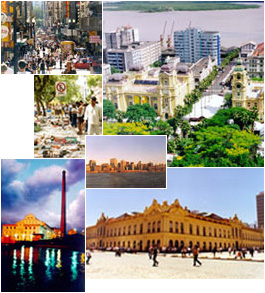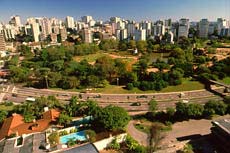Advertising by Google
Porto Alegre, Rio Grande do Sul
Area: 496 km2
Population: 1.416.363 inhab. (est. 2004).
Visit map of Rio Grande do Sul.
The name Porto Alegre means Happy Port.
The word gaúcho used to designate the cowboys of the pampas, but nowadays it is used to refer to any person born in the State of Rio Grande do Sul.
First settled by Portuguese of Azorean descent in 1777, Porto Alegre, the capital of Rio Grande do Sul was at a disadvantage for many years because of its location some distance away from the sea. From the nineteenth century, with German colonization and the building of the first railways, the city began to expand rapidly until becoming the most important city in southern Brazil.

Photo by the Tourism Board
Situated on the left bank of the River Guaíba near the port of Porto Alegre, important for transporting local produce, the Gaucho capital has a broad-based economy that lays particular emphasis on agriculture and industry. Agricultural production includes produce such as plums, peaches, rice and cassava grown on rural smallholdings. The shoe and leather industries are also important, especially in Novo Hamburgo, in the metropolitan area of Porto Alegre.
If the capital was disadvantaged in the beginning by its geographical position, it is now deriving great benefit from it. With the creation of Mercosul, comprising four countries of which two, namely Argentina and Uruguay, border Rio Grande do Sul, Porto Alegre has almost taken on the role of capital of the Southern Cone.
Porto Alegre is the centre of Brazil's third largest communications network, the Brazil South Network (Grupo RBS) and one of the foremost education establishments, the Federal University of Rio Grande do Sul. One of the city's main tourist-cultural attractions is the Mário Quintana Cultural Center based in the former Hotel Majestic where the poet lived until 1980, before his death in 1994. The Cultural Centre comprises auditoria for both theatre and cinema, libraries and an art gallery as well as housing a vast collection of material relating to Mário Quintana, one of the greatest Brazilian poets of all times.
 In the Matriz Square in Porto Alegre there is an architectural complex in the Portuguese baroque style, a legacy of its founders. The most important buildings are the São Pedro Theatre, which is more than one hundred and thirty years old, the Metropolitan Cathedral, built in 1929 in Renaissance style (the Cathedral is accepting donations for the refurbishment in progress), the Public Market, the Town Hall and Riachuelo Street where the city's bookshops, both new and second hand, are situated. Not far away is the Gasometer Factory which used to operate as a thermoelectric plant but is nowadays an important cultural focus in the city.
In the Matriz Square in Porto Alegre there is an architectural complex in the Portuguese baroque style, a legacy of its founders. The most important buildings are the São Pedro Theatre, which is more than one hundred and thirty years old, the Metropolitan Cathedral, built in 1929 in Renaissance style (the Cathedral is accepting donations for the refurbishment in progress), the Public Market, the Town Hall and Riachuelo Street where the city's bookshops, both new and second hand, are situated. Not far away is the Gasometer Factory which used to operate as a thermoelectric plant but is nowadays an important cultural focus in the city.
In recent years, Porto Alegre hosted the World Social Forum, an initiative of several Non Government Organizations which criticize the supremacy of capitalism in the international economic relations, and advocate that Governments and corporations should have a deeper social concerns when implementing their politics.
The WSF had sponsorship by the City Government of Porto Alegre; in 2002, the Worker´s Party, which had been ruling the city for sixteen years, didn´t manage to elect his candidate; as a result, it is possible that the WSF be moved to other cities, in future events.
Porto Alegre always welcomes their visitors. Pride of theirs traditions, don't be surprised if a gaúcho offers you one mouthful of his/her chimarrão that he/she is drinking - one infusion of matt herb in very hot water, prepared inside calabashes and absorbed by silver straws/pumps. Consider the gesture a sincere declaration that you're welcome.
Read more:
 Porto Alegre official site. Maintained by the City government.
Porto Alegre official site. Maintained by the City government.
 Universidade Federal do Rio Grande do Sul. The Federal University of Rio Grande do Sul, campus in Porto Alegre.
Universidade Federal do Rio Grande do Sul. The Federal University of Rio Grande do Sul, campus in Porto Alegre.
 Porto Alegre. Information in Portuguese.
Porto Alegre. Information in Portuguese.
Back to Top